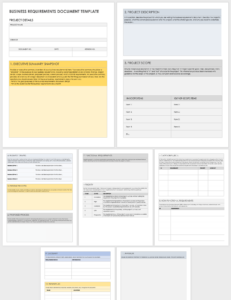A software business requirements document (BRD) is a crucial document that outlines the functional and non-functional requirements of a software product. It serves as a shared understanding between stakeholders and the development team, ensuring that the software meets the business objectives. To streamline the creation of a comprehensive BRD, utilizing a software business requirements document template can significantly enhance efficiency and accuracy.
A well-structured template provides a framework for organizing and capturing all necessary information, ensuring completeness and clarity. It guides users through essential sections, such as project scope, business objectives, user stories, and acceptance criteria. By leveraging a template, businesses can save valuable time and effort while producing a high-quality BRD that aligns with industry best practices.
Crafting a Comprehensive Software Business Requirements Document
To create a comprehensive software business requirements document, it is essential to gather input from key stakeholders, including users, subject matter experts, and management. A thorough understanding of their needs, expectations, and pain points is paramount. The BRD should clearly define the software’s scope, outlining its functionality and limitations. It should also specify the business objectives that the software aims to achieve, ensuring alignment with overall organizational goals.
User stories are a powerful tool for capturing user requirements in a clear and concise manner. They describe the functionality of the software from the user’s perspective, providing valuable insights into their needs and expectations. Acceptance criteria define the conditions that must be met for each user story to be considered complete. By establishing clear acceptance criteria, the development team can ensure that the software meets the intended requirements.
Non-functional requirements are equally important to consider in a software business requirements document. These requirements address aspects such as performance, reliability, security, and usability. They ensure that the software meets the necessary technical standards and user experience expectations. By thoroughly capturing both functional and non-functional requirements, the BRD provides a solid foundation for successful software development.
The software business requirements document should be a living document that evolves throughout the software development lifecycle. As the project progresses, it should be reviewed and updated regularly to reflect changes in requirements, design, and implementation. This iterative approach ensures that the BRD remains current and aligned with the evolving needs of the business.
Value of a Well-Structured Software Business Requirements Document
A well-structured software business requirements document offers numerous benefits. It facilitates effective communication among stakeholders, ensuring that everyone shares a common understanding of the project goals and requirements. By providing a clear roadmap for development, it minimizes costly rework and delays, resulting in faster time-to-market. Additionally, a comprehensive BRD enhances project accountability, as it serves as a reference point for all parties involved.
Furthermore, a well-crafted BRD can improve the quality of the software product. By capturing all relevant requirements upfront, it helps to prevent omissions and errors that can lead to costly defects down the road. It also provides a solid foundation for testing and validation activities, ensuring that the software meets the intended specifications. By investing time and effort in creating a comprehensive software business requirements document, organizations can significantly increase their chances of successful software development projects.
Conclusion
A software business requirements document template is an invaluable tool for streamlining the creation of a comprehensive and effective BRD. By providing a structured framework and guidance, it ensures that all necessary information is captured and organized. A well-crafted BRD fosters effective communication, minimizes development risks, and enhances the quality of the software product. Ultimately, by leveraging a software business requirements document template, organizations can streamline their software development process and achieve superior outcomes.
Remember, a software business requirements document is an essential cornerstone for successful software development projects. By investing in a comprehensive and well-structured BRD, organizations can lay the groundwork for clear communication, efficient development, and high-quality software products that meet the needs of their users and drive business success.

